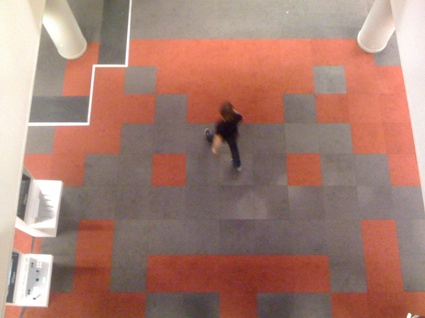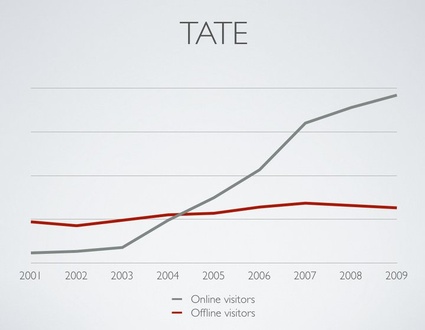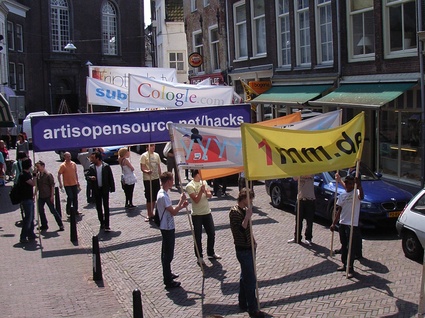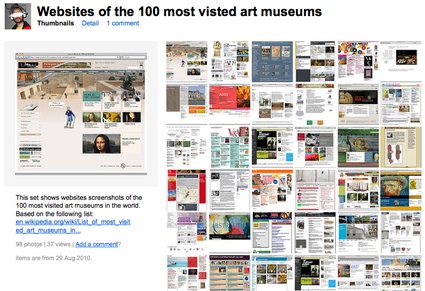I’ve stopped publishing interviews a long time ago but once in a while i stumble upon someone whose work and ideas sound so relevant to my interests that i immediately get back on the interview track. A couple of weeks ago, Rui Guerra answered one of my facebook rants (which usually target museum press people who refuse to give me access to press images because i’m a blogger therefore ‘images are not safe” with me) with a comment so smart and informative that i wanted to know more about his opinion about online strategies for cultural spaces.
Guerra is teaching, working and collaborating with the likes of V2_, Laboral Art and Industrial Creation Centre, Piet Zwart Institute and the Royal Academy of Art in The Hague. He is also the co-founder of ʻItʼs not that kindʼ (INKT), a studio focused on developing online strategies primarily for the cultural and creative sector. Besides working commercially, INTK develops artistic projects that explores the intersection of art, technology and society.
 INTK studio is located at the Dutch Game Garden, in Utrecht
INTK studio is located at the Dutch Game Garden, in Utrecht
You’re working on developing online strategies for cultural institutes. You’ve recently worked for two institutions that are beacons in the world of new media art, V2_ and LABoral. Can you explain us what you did for them? And if working for a cultural institute specialized in art and tech is any different than working for a more ‘traditional’ cultural center? Do they have different expectations and requests?
Rui Guerra: Cultural and heritage organizations, including new media art organizations, often regard their online presence as a marketing strategy. Their website and other online activities are traditionally run by a communication department (or public relations). This led to the current situation where websites are regarded as announcement platforms or brochures. Surely, there are exceptions but the current rule is to use online technologies as a marketing tool to attract visitors to physical locations. This scenario is changing rapidly. In 2001, the number of people who visited the four Tate museums was approximately twice as large as the number of visitors of the Tate website. In 2004, for the first time in history, the number of online and offline visitors was comparable. Five years later (2009), the number of online visitors was three times as high as the number of people that visited all Tate museums combined. The rapid growth of a 24h/7 online audience is awakening organizations for the fact that websites are much more than just mere flyers. An online platform with a growing world wide audience might very well be an extremely valuable ʻvenueʼ. Wouldn’t it be ironic if in the near future, offline exhibitions would be just a marketing strategy to attract visitors to websites?
 Comparative graph based on TATE’s annual reports
Comparative graph based on TATE’s annual reports
Online platforms have changed so rapidly that it might be important to revise current strategies. The online strategies that we at INTK develop together with organizations start from the point of view that a website is a platform in itself and that it is meant for an online audience. This is not a unique point of view, see for example, the ten principles that John Stack published at the Tate Online Strategy for 2010-12. The resulting online strategies can be quite comprehensive covering aspects in terms of content, context, business model, identity, interaction, communities, software and maintenance. So the changes that might occur due to a new online strategy are not just in terms of software but also organizational. Based on my experience, the ability to adopt new technologies does not depend directly on whether organizations include technology in their subject of interest but rather how fast and flexible they are in adapting to changes and new ways of working.
In a previous online conversation you mentioned the catalogue issue and how institutions invest time, money and energy to print beautifully designed catalogues but pay little to no attention to the possibility of publishing the same content online.
What arguments do you use to convince them to modify their attitude? What can art institutions gain from providing their web visitors with an online catalogue? Does the catalogue have to be available for free?
Rui Guerra:I was often surprised how efficient institutions are in collecting information to print in catalogues and how clumsy they are with publishing similar content online. Most of the organizations we’ve worked with do not need to be convinced to publish their content online. It is well-known that via the internet you can reach an audience that would be unthinkable 10 years ago. The urge to publish online is already there, what is missing are online publication models fine-tuned to the specific needs of cultural organizations.
Let me describe some of the challenges my colleagues at V2_ and me have encountered while developing their online strategy. V2_, Institute for the Unstable Media, just like many other organizations, had two different websites: one used to announce news and events and an online archive where all activities are documented. This approach not only divided the visitors, it also doubled the amount of work for the already scarce human resources. The solution passed through merging the two websites. The announcement platform and the archive platform had to be one and the same. Now it sounds like a no-brainer but it was not obvious back then. How can you present fresh news while at the same time show a rich archive of the last 30 years? How can you stay light and engaging while at same time remain informative and interesting? These were some of the questions we had to answer. New content needed to be historically contextualized using archived information while at the same time visitors searching for historical content should be informed about recent developments or events.
We needed a model that would be simultaneously temporal and semantic. We implemented a system that allowed editors to relate content in a semantic manner and presented it in a well structured page. Besides that it was also important to include relations that only emerge with time. With that purpose in mind, we developed a ʻrelated contentʼ system that is presented in all pages and is driven by meta-information. All content is documented with tags but instead of showing the tags to the visitors, we use them to search for archived content and to generate a related items list. This is not much different from youtube related videos or from what a lot of bloggers do by manually linking new blog posts to previous related ones. It sounds like the obvious thing to do but when you think about it, you realize that such systems are not commonly used. The new website was developed using existing open source software (Plone) and new functionality was added as open source modules. The new software was in place within the first 3 months followed by progressive adaptations until we achieved a quite stable system that can be downloadable from http://www.culturecab.org Currently, you can use V2_’s website as a research tool or at least as a comprehensive catalogue of their activities. Since the new strategy has been launched, V2_ online audience has tripled last year and recently, they had a video on youtube that has reached more than a million views.
About making content freely accessible online, we think that each organization needs to carefully think about a sustainable business model. Overprotecting content might drive you to oblivion and exclude society from a fundamental part of culture. On the other hand, you do not want to see others deriving profit from your assets at your own expenses. There is a beautiful publication freely available online that is a great introduction to business model innovation for culture heritage (PDF.) Business models are an important part of a thoughtful online strategy.
How about the audience? Do we already expect to find PDF of catalogues? Would we be curious enough to visit the online version of an exhibition? Or do we still cling to our old habits?
Rui Guerra:There are fundamental differences between an exhibition, a printed catalogue and an online platform. They have different goals and serve different needs therefore they are not mutually exclusive, in the contrary, they complement each other. You could say that exhibitions and catalogues are like snapshots of a given cultural context, they happen or are published at a certain period in time. Online platforms have the potential to be dynamic to evolve along with time. Theoretically, websites offer an unlimited amount of information and multiple views offer that information. With so much potential, one wonders why websites that offer a great cultural experience are so scarce? Again, I think we are lacking befitting models. You can find online exhibitions modeled after a book, after a DVD, after a physical space, after a geographic map, even modeled after an archival database. Applying old models, or dumping catalogues in PDF format online, is not going to get the job done.
 Michel de Broin, Shared Propulsion Car (pull over by Toronto Police), 2007. Exhibition Auto. Dream & Matter at Laboral
Michel de Broin, Shared Propulsion Car (pull over by Toronto Police), 2007. Exhibition Auto. Dream & Matter at Laboral
We’ve recently launched the new online platform of LABoral, Art and Industrial Creation Centre, in Spain. LABoral exists only for approximately four years. In such a short time, they have organized more than 40 exhibitions, presenting more than 700 artworks and invited approximately 600 artists. During that period thousands of images, texts and videos were created. LABoral exhibitions are overwhelming in terms of information. The new online platform had to reflect that proliferation of content while at the same time take in attention the visitor’s online experience. The website that resulted from their new online strategy uses a minimal design, basically it lives from its content. The pace of the
experience is defined by the user. For example, have a look at the works presented at the exhibition Auto. Dream & Matter in 2009. You can browse through the artworks without having to wait for page loads. This means that you can decide the speed you watch the artworks. If you find anything that interests you just click (or tap) on it and you will get detailed information about the work, author and other artworks from the same author that have been exhibited at LABoral. As you can notice from the website, we integrated images, videos and sounds seamlessly. The system is far from perfect but as other organizations get interested, we hope to improve it very fast. For example, we hope to receive some funding in order to integrate an HTML5 video player so that we no longer have to depend on proprietary platforms. We are far from being able to claim that we have an ideal model. In fact, that might be an utopia. But we can guarantee you that we spend a big part of our day working on it.
What could be the benefit for a museum or an art gallery to have their online audience grow? Why, for example, would they want to reach people who might never be able travel and visit their shows?
Rui Guerra: The main benefit of having a large online audience is surely not to attract visitors to offline shows. An increasing online audience might lead to a raise of the number of offline visitors but we think that is just a side effect of something more relevant. There is a clear interest in consuming information and in experiencing art online. In 2008, people under-25s already spent 36% of their leisure time online. Art organizations realize that it is essential to tap into this audience in order to reach a younger and broader public. To adapt to this new audience is their urge. The benefits are diverse and might be not only for the organizations but also for the public in general. For example, the artworks that are accessible to the public represent just the tip of the iceberg when compared to the collections owned by cultural organizations. Either from space limitations or any other reason a large amount of our culture is not easily accessible. Organizations are already publishing much of their collections online, the process has been slow mainly because most works need to be digitalized. Currently digitalization techniques are relatively cheap and governments have been funding a big part of this process so you can expect an increase in speed. Nobody can predict the impact of this process but you can expect big changes. Think for example what Taschen has done in its early period when it published less known artworks in a magazine format.
The full benefits of an online audience can only be harvested once organizations realize that websites are not just publishing channels but more importantly they are interactive platforms that allow audiences to engage with art in unique ways. The nature of an online experience is radically different from an offline one.
It cannot be expected that art originally made to be hanged on a wall will perform equally good on a screen. Adapting artworks that were made with one medium in mind to another medium does not always result well. The full potential of a medium can only be explored by works that have been conceived with that medium in mind. Such artworks are no longer rare and in fact there has been an impressive proliferation of digital artists communities making works that can only be fully perceived once experienced online. These art forms surely deserve more attention.
Over the past few years, curators, artists, other individuals or institutions have experimented with setting up galleries that exist purely online. Is that an experience you’d regard as meaningful and timely?
Rui Guerra: Yes there has been important precedents. Adaweb and runme.org are two examples that first come to my mind. Runme.org is an online repository for software art which in a way represents an important generation of software artists. There also have been successful initiatives run by cultural organizations, such as, the Intermedia Art by the Tate and Artport by the Whitney Museum. However, once artists control both the means of production and distribution, as it is often the case with software art, one might question the role of institutions or even the role of online exhibitions. We have participated in an exhibition organized by JODI where these concerns where dramatically expressed. As curators of the show, the duo decided that no computers would be presented in the gallery. Instead a silent manifestation was organized where the URLs of all projects were paraded in gigantic banners throughout the streets of Dordrecht in the Netherlands. Art projects that are available online can be easily accessible as long as their internet address is known. Some of these projects have been created taking in mind an audience that would access them from their own computer, so it is logical to question the typical white cube scenario.
 Photo impression of the manifestation in Dordrecht
Photo impression of the manifestation in Dordrecht
Consciously or not these works are definitively reshaping the relationship between artists, cultural organizations and the public.
You recently won first prize in the competition ARTE 2.0 VOCENTO: the art of exhibiting art online. Your proposal “Everybody is a curator” challenges current hierarchies in the art world and explores new forms of interaction and participation among the general public. Can you tell us more about the project and what you tried to achieve with it?
Rui Guerra: The proposal Everybody is a curator is integrated in a long term research focused on the relationship between software and curating. The prize was quite important for INTK not only in financial terms but also as an impulse to experiment with techniques and approaches for which we might not have an obvious business model. We think it is important for artists to explore alternative ways of presenting and distributing their work. In a nutshell, the proposal explored the notion that websites cannot be perceived as isolated islands and in fact they are nodes of a larger network. To give an example, INTK has been developing a series of creative interventions meant for existing websites. So rather than presenting works on our website, we prefer to install our projects in a guest website for a specific amount of time. This approach introduces several novelties. We can reach different audiences depending on which website the work is installed on. The website regular online audience has certain expectations, they are accustomed to the interface and aesthetics so the changes that our interventions introduce often create a strong impact.
For example, last November there was a national protest in the Netherlands against planned cuts in government arts funding. In order to increase the awareness among an online audience, we released a script that could be included in any website. The code literally tilted the website in order to reveal the national campaign in the background. To our surprise in less than 24h several organizations and individuals had their website tilted. We are quite fascinated about this approach. While we should be searching for a renowned gallery to represent our work, we prefer to spend our time checking websites that we would like to run our scripts on. In terms of audience numbers, it might be more interesting to show our work on google.com than let’s say at moma.org but until now cultural institutes have been more receptive to our interventions than other organizations.
Online intervention ʻNederland Schreeuwt om Cultuurʼ
Is there any contemporary art institution you think is in need of a serious
revamping of its online strategy?
Rui Guerra: Haha! Half a year ago, we made a survey of the 100 most visited museums and inspected their websites. You can still find the screenshots in a Flickr set. We think that most of them are in urgent need of help. But seriously, creating an online strategy means to work closely with an organization, so rather than pick up the desperate cases we would prefer to work with organizations that challenge us. We imagine that eyebeam.org would be a great place to experiment and try out new models.
On the other hand, we have been increasingly interested in online platforms for recurrent events, such as, festivals and biennales. It strikes us, this approach of creating an new website for each edition of a festival. We really would love to see a platform that could evolve along with the festival. Besides that, we think such events are an intensive social experience and that online platforms could play a larger role before, during and after the event.
 Websites of the 100 most visited art museums
Websites of the 100 most visited art museums
And one that sets the example?
Rui Guerra: I do not think that there is any cultural organization that can be a role model in its entire online strategy. There are several isolated initiatives that can be praised. The videos published on the Tate channel work really well online. They are short and engaging. I’ve been watching them for a while now and I can’t get enough. Ubuweb, which is not an institution but an endeavor of a small group of people, have done an amazing job in terms of publishing art related content. It has become an essential tool for any art educator. One could say that, they are the art wikileaks. Guys if you are listening; backup all that data and release it on a peer-to-peer network before is too late. Google art project is at the same time encouraging and disappointing. It is nice to see museums open up in this way but quite disappointing to see that google approaches all information with an standard methodology. To google it does not seem to make any difference whether we are talking about the earth, the human body or art. I could go on mentioning isolated initiates but these are just pieces of a puzzle that no one has managed to put neatly together into a cohesive online strategy.
Thanks Rui!
